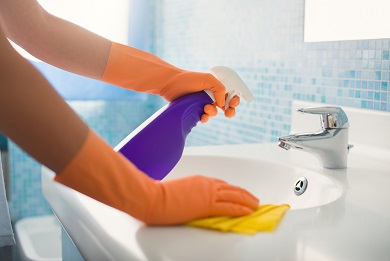
NATIONAL REPORT—Whether it’s in the context of commercial or home cleaning, going green is an important consideration. The damage of the cleaning industry as it currently exists extends to individual health and impacts the larger climate.
The chemicals in cleaning products can damage your health. These chemicals can also enter the environment through the water system. For example, if you flush a toilet or empty a mop bucket down a drain, then that means the ammonia, acids, and other chemicals are going into the environment.
Thousands of chemicals just from cleaning products are washed into rivers, streams, and oceans every day.
Below is a guide to green cleaning practices, including some reasons it’s important, aside from the environmental factor.
How Do Cleaning Products Affect Your Health?
Whether designed for home or commercial use, cleaning supplies and products can release dangerous chemicals.
These chemicals include volatile organic compounds (VOCs). Other ingredients that are dangerous to human health include bleach and ammonia.
You can develop chronic respiratory problems, headaches, and allergic reactions when exposed to VOCs regularly and the other chemicals released from cleaning supplies.
VOCs are emitted as gasses, with short- and long-term adverse effects on health. The concentration levels of many VOCs are higher indoors than outdoors.
Short-term effects of VOCs and other ingredients in cleaning products can include nose, eye, and throat irritation, nausea, headaches, and loss of coordination. Over time, longer-term effects can include liver, kidney, and central nervous system damage, and some are suspected or known to cause cancer in humans.
Cleaning product ingredients usually fall into one or more of three categories.
- Carcinogens are ingredients that cause or promote the development of cancer.
- Endocrine disruptors can replicate the effects of human hormones. Endocrine disruptors can cause false signals in the body and lead to premature puberty, menstrual issues, infertility, and miscarriage.
- Neurotoxins are the third category. These substances can affect your brain activity and lead to memory loss and headaches.
To reduce exposure, you should make sure that you’re using ventilation and follow all the instructions on the label.
Trying to reduce your exposure overall is a better option.
Cleaners to Avoid
Some of the particular types of cleaners that may have the most detrimental health effects include:
- Air fresheners—even when an air freshener is marketed as being unscented, these products can trigger allergies and asthma. Many of these products contain chemicals that are harmful to your lungs.
- Dryer sheets and fabric softener—the primary problem with these is that they have fragrances that can cause lung irritation, asthma, and allergies.
- Antibacterial cleaning products—since the pandemic, these have become more popular even though bacteria don’t cause COVID. The harm of these cleaning products may be that they encourage the development of drug-resistant super bacteria.
- Corrosive cleaners—these products are marketed as being used to clean toilet bowls, ovens, and drains. These are among the most dangerous cleaning products available and can cause severe burns.
- Ammonia and bleach—these cleaners produce fumes that can be highly toxic to the respiratory system. In some cases, these products can even damage the lungs. Ammonia is often found in glass cleaner, and it’s also linked to damage to the mucous membranes and the cardiovascular system.
- Chlorine—these products are used in laundry whitener and toilet cleaner and are linked to thyroid problems.
- 2-butoxyethanol—this ingredient is often in multi-purpose cleaners and is associated with kidney and liver damage.
- Perchloroethylene—frequently found in carpet and fabric cleaner, this ingredient is associated with neurological problems and certain types of cancers.
- Formaldehyde—found in heavy-duty industrial-strength cleaners, this ingredient has been linked to neurodegenerative amyotrophic lateral sclerosis (ALS).
What is Green Cleaning?
One way to reduce toxic exposure at home or in the workplace is to use only green cleaning methods.
Green cleaning is a broad term with varying definitions, but generally, the goal is to reduce individual and environmental exposure to chemicals and toxins.
Green cleaning means they only use substances like lemons, vinegar, and baking soda for some people.
There are also manufactured cleaning products marketed as being green. These products typically don’t contain chlorine, phosphates, artificial fragrances, or artificial colors. They might also be made with organic ingredients and come in recyclable or biodegradable packages.
Some green cleaning products are certified as fair trade, which means they meet both environmental and labor standards during production.
How Do You Know If a Product Is Green?
The best thing you can do to determine whether or not a cleaning product is actually green is to read the label. In the United States, the Environmental Protection Agency (EPA) mandates that labels be placed on products that meet their criteria regarding chemicals.
For example, you might see products in America labeled as no-VOC or low-VOC.
The Ecolabel is awarded to products and services that meet stringent environmental standards in the European Union.
If a service or product has the EU Ecolabel certification, it indicates it meets the criteria to be categorized as lowering environmental impact. During the product or service development, the designation also indicates consideration has been given to reducing waste and increasing recycling.
Hiring a Cleaning Company
Finally, if you do your own cleaning, you can become greener simply by throwing out your store-bought solutions and making your own.
If you’re hiring a cleaning service, you should look for one that uses eco-friendly and health-conscious products.
For example, you might choose a company that uses biodegradable cleaning products and water-based products.
As well as reducing toxic exposure, cleaning companies that use microfiber are more environmentally friendly and reduce their carbon footprint.
Microfiber is a blend of nylon and polyester and has a positive electric charge that attracts dirt like a magnet. The result is a better, more thorough clean with fewer products, and these aren’t single use, so you’re reducing waste.
You don’t have to do everything at once if your goal is greener cleaning. Even small steps, done incrementally, will be better for your health and the environment.







